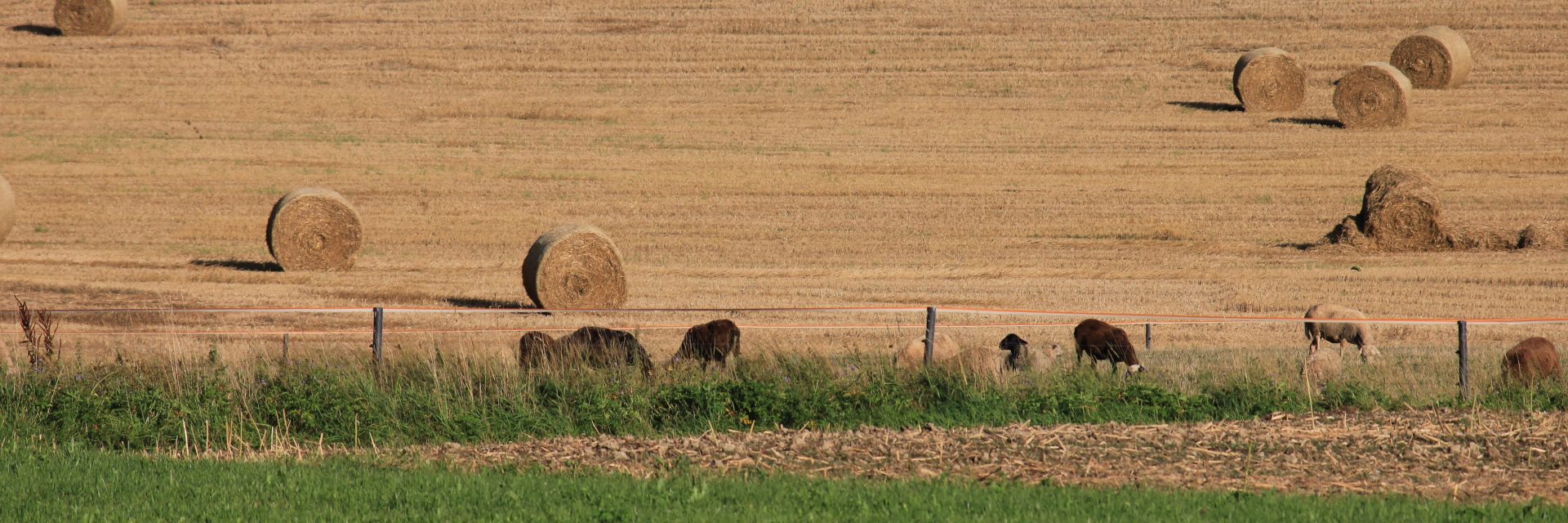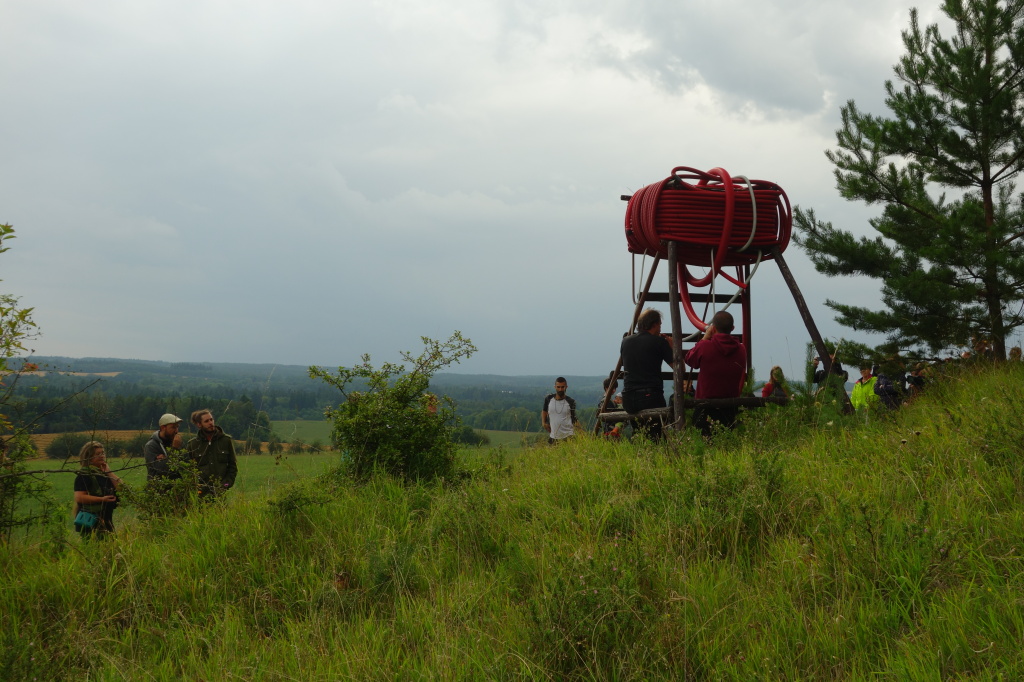KRA – Kravín Rural Arts as a garden laboratory
/text by Lenka Dolanová for ALOTOF – A laboratory on the open fields publication, translated by Adrian Dean/
The location is the foundation! – a former cowshed (in Czech: kravín) on the periphery of a village, Hranice u Malče, is home to KRA: Kravín Rural Arts. The name given to this site and the organisation itself does not only refer to the building’s former use, but also to melting icebergs (in Czech: kra) as a symbol of environmental crisis. An iceberg, a solitary sanctuary floating in the ocean, characterises this site both visually and symbolically. This tall two-storey building, a rare example of a late-baroque manorial farm in this district and formerly part of a seigniorial estate, stands out with its scale and significance. We want to take up its rich history in a modified form. KRA should function as an island for artistic, cultural and environmental initiatives, a place for gatherings and a range of creative and social activities. And finally there is a reference to the raven’s croak: KRAA-KRAA. Ravens are apparently one of only a few wild animals who make their own toys. In mythology the raven is a trickster who breaks rules, ignores convention and acts unpredictably. For us the raven symbolises art, playfulness and creativity.
Since July 2014 KRA has hosted a number of activities as part of the ALOTOF (A Laboratory On The Open Fields) project. I shall attempt to outline these activities’ repeated rituals, visitors and models for action, discussion and creativity. The first question was how the garden could be used for art work, and here we interpreted “garden” in the broadest possible sense (according to Murray Bookchin’s Ecology and Revolutionary Thought, the entire countryside can be seen as a garden, and “the land must be cultivated as though it were a garden” [1]). In using this rural garden we have taken modest excursions into solar energy, made use of the wind, worked with soil, seeds and plants, and we have also learned something about water. These activities have involved neighbours, musicians, filmmakers, children, gardeners, cooks, hunters (and game), beekeepers and artists. We have continued our work on establishing a rural network of allied initiatives in the form of RurArtMap, a printed and online map.
For our first event, SolarKRA (3-7 July 2013), we invited a German artist, Ralf Schreiber [2], who works with minimalist robotics. He makes self-sustaining sound installations that use a small amount of energy to produce sound and motion. During the workshop we assembled small solar-powered kinetic sound sculptures in preparation for the potential future use of more complex solar-powered systems, e.g. for monitoring bee colonies. These sculptures variously combined motion with sound that resembled most of all the chirping of crickets. People slept in tents in the garden and washed in solar-heated showers.
In autumn we tidied up the KRAlab garden and planted trees and bushes, and then to celebrate spring we went to Dúbravica in Slovakia, where Periférne Centrá [3] had organised a month-long event called Fruit of Art (5 April – 4 May 2014), a celebration of spring and creative work. This included fruit-growing courses (cutting and grafting fruit trees) led by the gardener and artist Martin Bendžela. Periférne Centrá is trying to cultivate a wild, overgrown orchard in a site named Čo (after a sculpture by the French artist Benoit Lazaro [4] that has been installed here since 2012). Other gardening activities included beekeeping courses and digging new beds. Dávid Turčáni gave a lecture on the work of his beekeeping organisation, Včelí kRaj. Those of us from Yo-yo presented RurArtMap, our map of rural art centres. For Kunstdorf Oto Hudec created a new structure, DBSP 01 (Dúbravica Beekeepers’ Space Programme), combining an apiary, library and reading room.
For our spring-summer working weekend we had planned to build a greenhouse and children’s playground with sandpit and raised beds, but this proved too much for a single weekend. We managed to finish the raised beds and later plant them with crops from Gengel [5] and seeds from Marek Kvapil [6], who presented a short course on seeds and taught us how to cultivate them, emphasising the free pollination of rare and old varieties. Our Polish partners organised the Nowina Land Art Festival (20–22 June 2014), a small village event that included performances, happenings, dancing and painting an old bus.
The idea behind Stands, Hunters and Animal Paths (18–24 August 2014) was to expand beyond our garden and explore potential sites for creative work. We were also interested in the theme of hunting: Czech hunters have recently been included in the intangible cultural heritage list. In spring we issued an invitation to produce temporary art projects that could be implemented in hunting stands, and we received replies from artists from the nearby town of Chotěboř, and also from Slovakia and Amsterdam. Nine artists and groups took part in reworking stands in various ways. In the meadow below the stands there was an exhibition of Kamila Musilová’s photographs of stuffed animals. On a walk around these stands marking the culmination of this week-long event, the artists presented their projects and there were sound performances and presentations by Dominique Leroy (who used microphones mounted on fishing rods that extended from a stand above the meadow to “hunt” ambient sounds), Martin Janíček (who wrapped a stand in flexible tubes fitted with game calls) and the duo Anti-Delusion Mechanism (who made an installation with several miniature stands, fitted with amplifiers and placed in various locations in the woods and meadows; one of them generated sounds from underground). The walk ended with an animal dance. In the winter of 2015 documentation from this project was presented at the Stands exhibition at the Vysočina Regional Gallery in Jihlava [7] (23 January – 8 February 2015). We presented Yo-yo’s activities under ALOTOF during the Open Studios festival, when artists from the Vysočina Region opened their studios to display their work (4–5 October 2014).
In mid-October we organised Singing Kites, when under the guidance of artist and kite maker Jan Poupě we tried to construct kites that would sing as they flew. However, kite flying was only briefly possible – it was a rare windless day – and only a few photographs were taken. The kites are still waiting to sing. To be continued!
This was followed in November by an exhibition and discussion with urban beekeepers Urban Beeing / Bees in the City (official opening 20 November, discussion 21 November 2014), when we expanded into the city and occupied Communication Space Školská 28 in Prague [8]. The discussion investigated some of what is said about beekeeping in the city, such as whether urban bees give more honey, and whether bee pasturage is more diverse in cities than in the countryside. We were also interested in urban beekeepers’ experience and motivation, and how the local beekeeping communities operated, and the pros and cons of the coexistence of people and bees. We invited beekeepers from various societies, mostly based in Prague, including beekeepers from Prague Zoo, the roof of Chodov Shopping Centre and the airport, and also from London and Brussels. Also represented was the Bee Research Institute in Dol, and biodynamic beekeeping was covered too. The conclusions can be quickly summarised: in all probability there are no fundamental differences between bees, bee pasturage and honey in the countryside and in the city. Urban beekeeping is currently in vogue, but it is nothing new. Interestingly the speakers and the audience agreed that we should return to more natural beekeeping methods: accepting the swarming instinct as something natural, using natural hives (built by bees), and letting bees spend the winter with stores of honey, rather than sugar. A highly inspirational gathering!
In March 2015, to celebrate spring and World Water Day, there was a prelude to the Convergence permaculture gardening festival, looking at water resources in the countryside and in the garden under the guidance of Zelený čaroděj. Part two, looking at edible gardens, will follow in April.[9], [10]
OTHER ACTIVITIES:
RurArtMap [11] is an affiliated Yo-yo activity that is part of the ALOTOF project. This is a map of rural centres for art, ecology and related areas. Since 2012 we have published a printed map with a programme for the summer months, and last year we launched an online version that should serve as a workspace for rural organisers, as well as a discussion forum and a portal for planning journeys.
Our partners have opened up other inspirational areas for us. Filip Kavka Smiggels from the Mlsná Kavka [12] restaurant in Karlín in Prague has already cooked for two of our events. He treats his cooking, using local ingredients, as a form of education, and introduces participants to new recipes.
We published our Honey Cookbook in collaboration with him. Similarly another partner, Lucie Pelouchová, comes from the Zastráň [13] vegetable farm just over the hill, where we buy fresh vegetables. Also related to food are our mushroom walks with mushroom aficionado Ivan Kidles from a nearby village, Víska. The Kino Na Beton cinema is a traditional venue for film screenings.
Another regular theme is walking, and old and new paths through the countryside. In the summer the Various Artists group [14] from Brussels organised a walking performance, Périphérique.0, treading out an entirely new path around part of the garden. To be continued next time.
AND FINALLY: WHAT NEXT?
Our activities comprise a less popular, more experimental parallel to rural events such as hunt balls, children’s carnivals, beekeeping meetings and annual gardening shows. We did not manage to do nearly as much as we had planned. The garden is gradually changing and for 2015 we plan to establish a natural permaculture garden. Perhaps more interesting are our options for the future.
Implementing our initial ideas came up against the harsh reality that public gatherings for artists are time-consuming in terms of organisation, arranging accommodation, food and transport and adapting the venue, and this leaves little time for creative work. So far we have always tried to operate somewhere between working encounters – in the form of (open) workshops – and events and exhibitions for the public. We still need a lot of time to truly turn the garden into a place for the activities described above. We are planning to build a greenhouse in line with OpenStructures principles, as well as observation hives and a children’s nature playground. In 2015 we will look at soil, and in 2016 our subject will be house and courtyard, and village storytelling…

